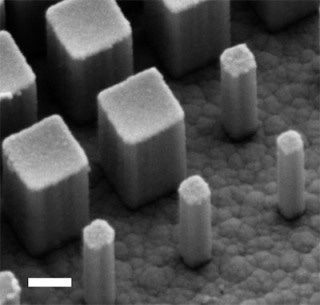Feb 9 2017
A new, flat lens with the ability to focus light with a higher efficiency within the visible spectrum was reported by a team of researchers from the Harvard John A. Paulson School of Engineering and Applied Sciences (SEAS) last summer. In order to bend and focus light as it passed, an ultrathin array of nanopillars was used in the lens.
 A scanning electron microscope image shows a side-view of the metalens, with nanopillars optimized to focus colors without chromatic dispersion. Scale bar: 200 nm. CREDIT: Image courtesy of the Capasso Lab/Harvard SEAS.
A scanning electron microscope image shows a side-view of the metalens, with nanopillars optimized to focus colors without chromatic dispersion. Scale bar: 200 nm. CREDIT: Image courtesy of the Capasso Lab/Harvard SEAS.
The report was acknowledged as a major advancement in the field of optics and was mentioned as one of the Science Magazine’s top discoveries in the year 2016.
However, one drawback in the lens was that it could focus only one color at a time.
At present, the same team has produced the first flat lens with the ability to function within a continual bandwidth of colors, i.e. from blue to green. While being close to the bandwidth of an LED, this bandwidth opens the door for new applications in spectroscopy, imaging, and sensing.
The study has been published in Nano Letters.
One main problem faced by researchers developing a flat, broadband lens is correcting for chromatic dispersion, or the phenomenon in which different wavelengths of light get focused at different distances from the lens.
Traditional lenses for microscopes and cameras—including those in cell phones and laptops—require multiple curved lenses to correct chromatic aberrations, which adds weight, thickness and complexity. Our new breakthrough flat metalens has built-in chromatic aberrations corrections so that a single lens is required.
Federico Capasso, Robert L. Wallace Professor of Applied Physics and Vinton Hayes Senior Research Fellow in Electrical Engineering
Therefore, in optics, it is highly significant to correct for chromatic dispersion, i.e. performing dispersion engineering, which is an important design requisite in any optical system dealing with light of different colors. The capacity of controlling the chromatic dispersion in flat lenses expands their implementation and makes way for new applications that are not practicable till date.
By harnessing chromatic aspects, we can have even more control over the light. Here, we demonstrate achromatic flat lenses and also invent a new type of flat lens with reverse chromatic dispersion. We showed that one can break away from the constraints of conventional optics, offering new opportunities only bound by the designer’s imagination.
Reza Khorasaninejad, first author of the paper and a Research Associate in the Capasso Lab.
In order to produce an achromatic lens, i.e. a lens without chromatic dispersion, the researchers optimized the width, height, shape, and distance of the nanopillars making up the heart of the metalens. Similar to the earlier research, abundant titanium dioxide was used by the researchers to form the nanoscale array.
Such a structure enables the metalens to focus wavelengths from 490 to 550 nm, i.e. fundamentally from blue to green, negating any chromatic dispersion.
This method for dispersion engineering can be used to design various ultrathin components with a desired performance. This platform is based on single step lithography and is compatible with high throughput manufacturing technique such as nano-imprinting.
Zhujun Shi, co-first author of the paper and a PhD student in the Capasso Lab
In an attempt to initiate the commercialization of this technology by setting up a startup company, Harvard’s Office of Technology Development has filed patent applications on a portfolio of flat lens technologies and is working in collaboration with Capasso as well as researchers in his team.
Alexander Zhu, Wei Ting Chen, Vyshakh Sanjeev, and Aun Zaidi coauthored the published study. The research was partially supported by the Air Force Office of Scientific Research. This research was carried out in part at Harvard University’s Center for Nanoscale Systems (CNS)—a member of the National Nanotechnology Coordinated Infrastructure (NNCI), in turn supported by the National Science Foundation.